Mary Engle Pennington was born in Nashville, TN, USA, on October 8, 1872. She studied chemistry at the University of Pennsylvania, Philadelphia, starting in 1890 and completed the requirements for a Bachelor’s degree in 1892. However, the university did not grant Bachelor’s degrees to women at this time, and she was given a certificate of proficiency instead. Nevertheless, she was admitted as a graduate student and received her Ph.D. in 1895 under the supervision of Edgar Fahs Smith [1]. After her Ph.D., she received a fellowship in botany at the University of Pennsylvania, followed by a fellowship in physiological chemistry at Yale University, New Haven, CT, USA.
Pennington returned to Philadelphia in 1898 and served as Director of the clinical laboratory of the Women’s Medical College of Pennsylvania. She also served as a Researcher in the Department of Hygiene at the University of Pennsylvania and as a bacteriologist at the Philadelphia Bureau of Health.
Starting in 1905, Pennington worked for the U.S. Department of Agriculture as a bacteriological chemist. She became Chief of the Food Research Laboratory there in 1907. In 1919, Pennington moved to American Balsa, a private company in refrigeration technology. She left this company to start her own consulting business, which she ran until her death. During the 1920s, she also worked with the U.S. National Association of Ice Industries (NAII). Mary Engle Pennington died in New York, USA, on December 27, 1952.
Food Safety and Refrigeration
Pennington is well-known for her pioneering work on safe food handling and refrigeration. Contaminated food and unsanitary handling conditions were important problems for public health at the time. During her time as Chief of the Food Research Laboratory, she developed standards for the safe processing of chicken—from the slaughterhouse to the consumer. Together with Howard Castner Pierce, she was awarded a patent for an all-metal poultry cooling rack [2].
Pennington also developed tests for the identification of spoiled foods and worked on methods for the optimal refrigeration of, e.g., eggs, poultry, and dairy to reduce bacterial growth. She researched the ideal temperatures for storing different foods and helped to improve cold storage rooms and fridges. She also worked on the design of refrigerated railway cars to keep food cold and safe during transport.
Pennington lobbied for upholding an unbroken cold chain, up to and even in the consumer’s home. This work was associated with the NAII, which was an association of icemakers and distributors who delivered ice for use in iceboxes, which were used before the advent of modern refrigerators. Due to her important work on food refrigeration, Pennington was sometimes called “The Ice Lady”.
Pennington was awarded the Garvan–Olin Medal from the American Chemical Society in 1940, was elected Fellow by the American Society of Refrigerating Engineers in 1947, and was the first woman elected to the Poultry Historical Society Hall of Fame in 1959. In 2002, she was inducted into the U.S. National Women’s Hall of Fame.
Mary Engle Pennington is the answer to Guess the Chemist (130).
References
[1] M. E. Pennington, Derivatives of columbium and tantalum, J. Am. Chem. Soc. 1896, 18, 38–67.
[2] M. E. Pennington, H. C. Pierce, An all-metal poultry-cooling rack, U.S. Public Patent no. 1,020,575, April 9, 1913.
Sources
- National Women’s Hall of Fame, Mary Engle Pennington, www.womenofthehall.org. (accessed on October 7, 2022)
- Chemical Heritage Foundation, Mary Engle Pennington, www.chemheritage.org. (archived version accessed on October 7, 2022)
- U.S. Food & Drug Administration, Mary Engle Pennington: The “Cold Chain” of Food Safety, www.fda.gov. (archived version accessed on October 7, 2022)
- Barbara Heggie, Ice Woman, The New Yorker, September 6, 1941.
- Biographical Snapshots of Famous Women and Minority Chemists: Snapshot – Mary Engle Pennington, J. Chem. Educ., jchemed.chem.wisc.edu. (archived version accessed on October 7, 2022)



